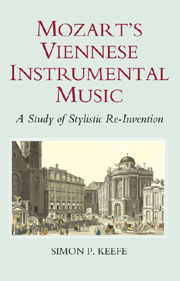Book contents
- Frontmatter
- Contents
- List of Musical Examples
- List of Figures
- For Celia, Abraham and Madeleine
- Acknowledgements
- Introduction: Mozart and Stylistic Re-Invention
- I PIANO CONCERTOS
- II STRING QUARTETS
- III SYMPHONIES
- IV CONCLUSIONS
- 7 Mozart's Stylistic Re-Invention in Musical Context
- Bibliography
- Index of Mozart's Works by Köchel Number
- Index of Mozart's Works by Genre
- General Index
7 - Mozart's Stylistic Re-Invention in Musical Context
from IV - CONCLUSIONS
Published online by Cambridge University Press: 05 September 2013
- Frontmatter
- Contents
- List of Musical Examples
- List of Figures
- For Celia, Abraham and Madeleine
- Acknowledgements
- Introduction: Mozart and Stylistic Re-Invention
- I PIANO CONCERTOS
- II STRING QUARTETS
- III SYMPHONIES
- IV CONCLUSIONS
- 7 Mozart's Stylistic Re-Invention in Musical Context
- Bibliography
- Index of Mozart's Works by Köchel Number
- Index of Mozart's Works by Genre
- General Index
Summary
IN Chapters 1–6 we have established that stylistic re-invention in Mozart's rpiano concertos, string quartets and symphonies constitutes an on-going, two-stage process. First, Mozart contemplates his pre-existent stylistic procedures in a genre, manipulating them to climactic effect. Thus, the confrontation in the development section of K. 449/i takes to a new stylistic plateau the separation of piano and orchestra interlocutors and the characteristics of development– recapitulation transitions from K. 413–415; the manipulation of striking harmonic procedures from the first five ‘Haydn’ quartets in the slow introduction of K. 465/i produces a rich peroration to the set as a whole and a sense of heightened contrast (slow introduction-exposition) new to Mozart's quartets; K. 491's intensification of the complementary qualities of intimacy and grandeur evident in the 1784–86 piano concertos results in Mozart's most dialogically sophisticated and confrontationally forceful concerto to date; and the voluminous, highly organized dialogue in K. 551/iv goes significantly further than its symphonic predecessors in terms of dramatic, teleological thrust. Next, as the second stage in the re-invention process, Mozart fundamentally reshapes stylistic features of his piano concertos and string quartets (but not his symphonies as K. 551 is his final work in the genre), reacting in various ways to innovative stylistic qualities of the climactic works., the accompanying orchestra's emphatic presence in K. 449/i as an interlocutor capable of confronting the piano and of participating fully in the musical action, sets the stage for the prominent role of the orchestra in the ensuing ‘grand’ concertos, especially the part it plays in balancing complementary qualities of intimacy, grandeur and brilliance; the stark contrast of Adagio and Allegro sections of K.465/i leads to the establishment of heightened contrast as a prevailing stylistic quality of the ‘Prussian’ quartets; and the stylistic apotheosis of K. 491/i stimulates a re-appraisal of how intimate grandeur (dialogue) and solo brilliance (piano virtuosity) are distributed in K. 503/i, 537/i and 595/i.
- Type
- Chapter
- Information
- Mozart's Viennese Instrumental MusicA Study of Stylistic Re-Invention, pp. 167 - 200Publisher: Boydell & BrewerPrint publication year: 2007



